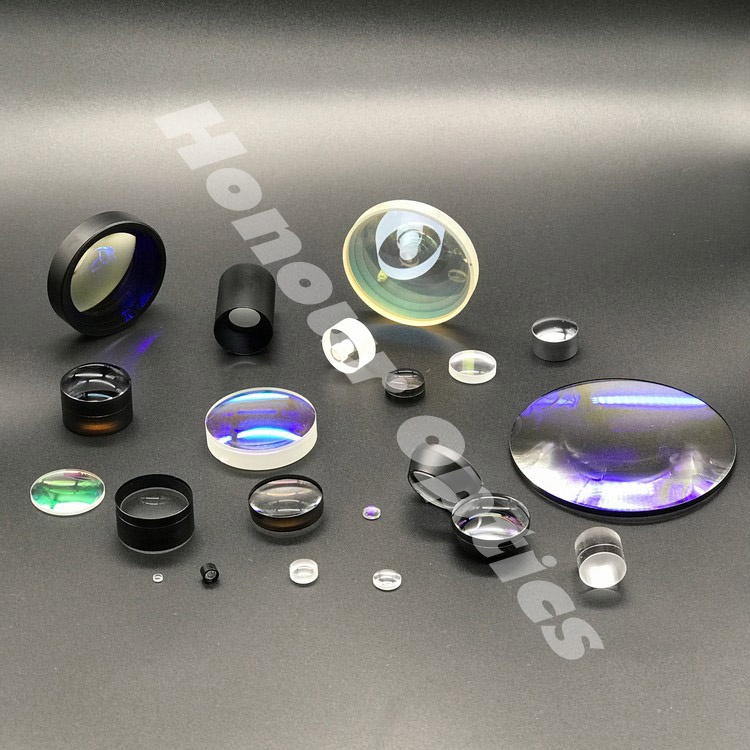
Lenses
Spherical lenses, also known as singlets, are transparent optical components consisting of one or more pieces of optical glass with surfaces so curved that they serve to converge or diverge the transmitted rays from an object, thus forming a real or virtual image of that object.
There are seven main spherical lens forms or shapes that determine the imaging characteristics of the lenses. They are plano-convex, plano-concave, convex-convex, concave-concave, meniscus, aspheric, and ball.
Plano-convex lenses have a positive focal length which makes them ideal for collecting and focusing light for many imaging applications. Plano-concave lenses have a negative focal length and are used for image reduction or to spread light. Convex-convex lenses have a positive focal length and are useful for 1:1 imaging and in multi-element systems and it’s also known as biconvex or equiconvex.
Concave-concave lenses have negative focal length, and are used for image reduction and to spread light and it’s also known as biconcave or equiconcave.
Meniscus lenses can increase the numerical aperture of a positive lens assembly, without an undue increase in the aberrations. Aspheric lenses compensate for spherical aberration and are used primarily for their light gathering ability. Ball lenses are used to provide short focal lengths for use with collimated light. They are often used in fiber coupling applications. The above seven are the most common types, meanwhile there are also other styles of spherical lenses available.
Higher Precision and capability:
technology | |
item | parameter |
curve rate radius | R≥1.7 |
surface form precision | N≥±1 |
△N≥0.1 | |
center thickness | d≥0.3 |
toleranceT≥±0.01 | |
cosmetic failure | ≥20-10 |
diameter | D≥1.8 |
toleranceT≥±0.004 | |
center thickness/diameter | 1/25 |
center deviation | C≥15″ |
coating | depends on request |
Processing technology:
1. polishing | |
dia.:φ1.8~125 | curve rate radius:R1.7~∞ |
fringeN:≥±1 | astigmatism△N:≥0.1 |
center thickness:≥0.3mm | center thickness/diameter:0.04~0.6 |
2. centering | |
dia. tolerance:≥±0.005 | centering:C≥15″ |
inner diameter. depth:15mm以下 | edge thickness:25mm以下 |
irregular shape/ D shape/H | Z parameter:≥0.02 |
3. coating | |
broad band anti-reflecting coating | |
high reflecting coating | |
beam splitter and various | |
4. cementing | |
dia.:φ3~100 | thickness tolerance:≥±0.01 |
lens group: below 4 single | |
5. painting | |
dia.:φ3以上 | lacqueer thickness:0.001~0.02mm |
silk-screen | |
Plano-Convex Lenses | |
Standard Specifications: |
|
Plano-Concave Lenses
Standard Specifications: |
|
Bi-Convex Lense
Standard Specifications: |
|
Bi-Concave Lenses
Standard Specifications: |
|
Achromatic Double Lenses
Standard Specifications: |
|
Cylindrical Lenses
Square Plano-Convex Cylindrical Lenses
|
|
Squarer Plano-Concave Cylindrical Lesses
|
|
| ||||||||||||||||||||||
C-Lens
Standard specifications: Max.Operating Temperature: 400℃ Transmission:: >99%(900 to 1700nm) Hygroscopic Susceptibility:: None Polarization Preservation: >0.99 Acid and Alkaline Resistance:Excellent Thermal Expansion Coefficient:<6x10-6 /℃ Maximum Power: >500mW Surface Quality:20/10 scratch & dig coating: R<0.25%@(Design wavelength)±40nm
|